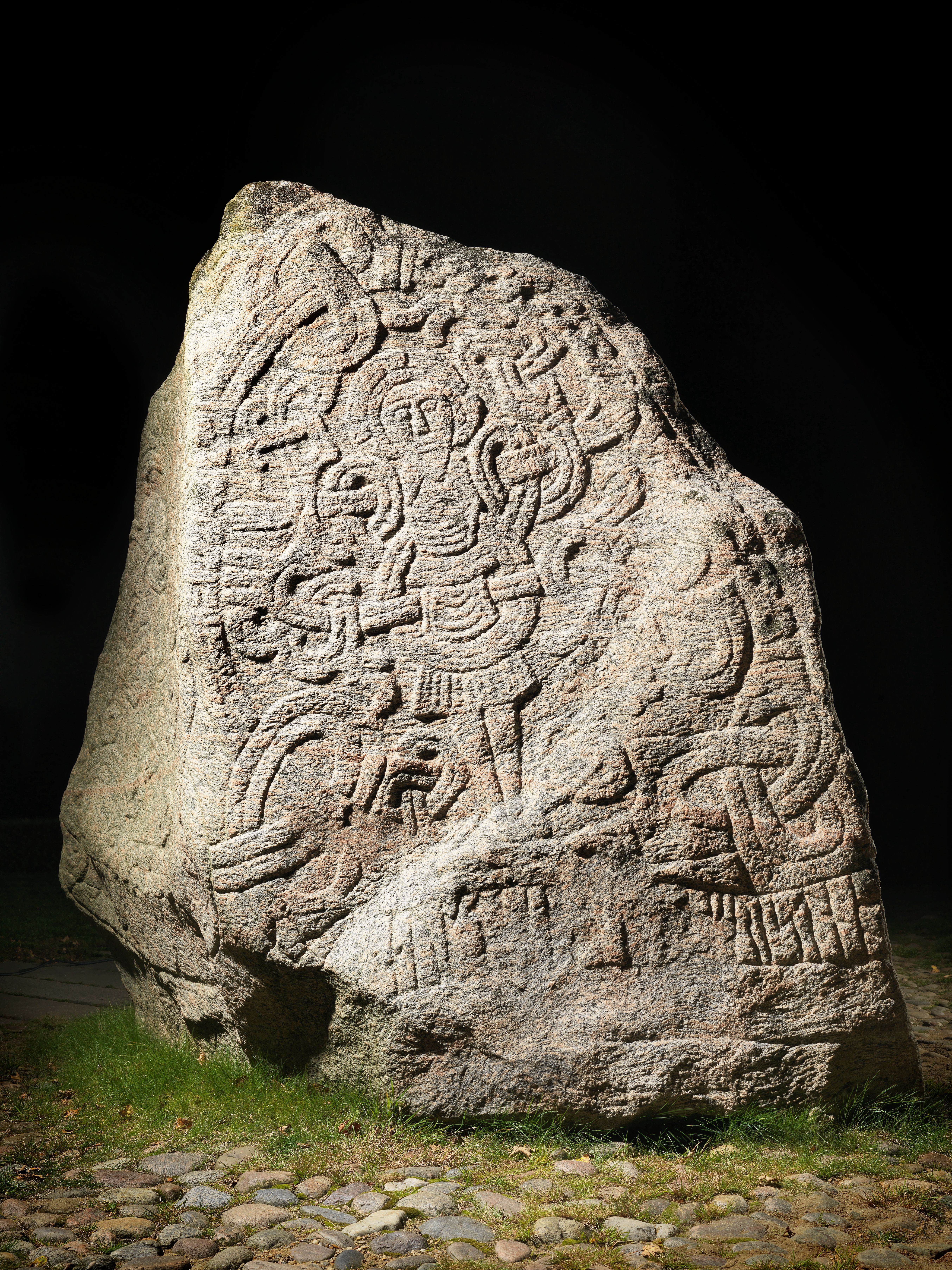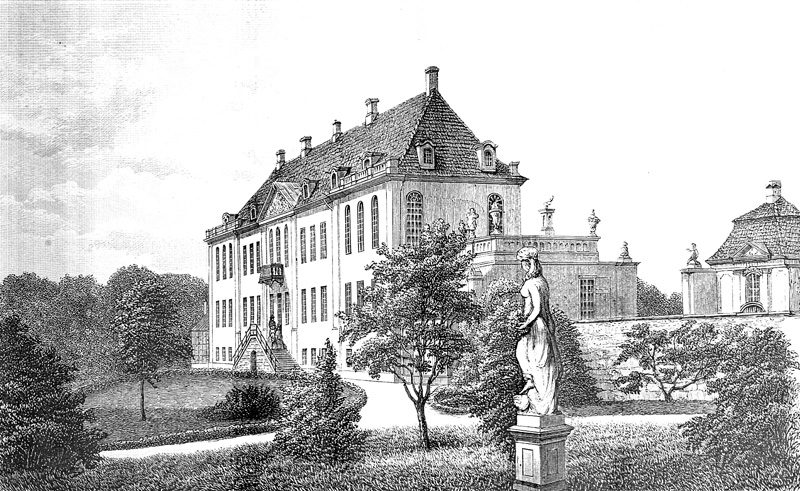|
Skullerupholm
Skullerupholm is a manor house and estate located in Lejre Municipality, Denmark. History The estate traces its history back to the 14th century. The first recorded owner of Skullerup is Anders Pedersen Uldsaks in 1326. It was later passed to his brother Sakse Pedersen Uldsaks. Ownership of the estate was later spread out between several simultaneous owners. In 1355, Sakse Yldsaks' daughter Ingebrog inhirited a stake in the estate. Ownership was subsequently spread out among several owners for the next many years. FrIn 1457-1461, Roskilde bishopric acquired all the stakes in the estate. It was subsequently managed as a fief. After the Reformation,, Skullerup was confiscated by the Crown. It was then operated as a royal fief. From 1554 to 1594. After the introduction of Absolute monarchy in 1660, Skullerupholm was ceded to the magistrate in Copenhagen. In 1663m it was acquired by Johannes Fincke. It was later ceded to his father-in-law, Henrik Müller, one of the largest landown ... [...More Info...] [...Related Items...] OR: [Wikipedia] [Google] [Baidu] |
Severin De Junge
Severin de Junge (28 November 1680 - 14 October 1757) was a Danish government official, Supreme Court justice and director of the Danish West India Company. During his time this was Denmark–Norway. He was on 6 April 1731 ennobled under the name de Junge. He owned Sonnerupgaard and Skullerupgård but economic difficulties forced him to sell both estates in the second half of the 1740s. Early life and education Junge was the son of War Commissioner and ''kammerråd'' Emanuel de June (1644–1692) and Bodil Sørensdatter Hiort (c. 1650–1724). He was appointed ''hofjunker'' in 1701 and the following year studied at Oxford University. Career Junge was in 1710 appointed as staff secretary of the later general and in 1720 elected for the important post as deputy of the Army's General Commission (''deputeret i landetatens general kommissariat''). He served as Supreme Court justice in 1715–35 and was an extraordinary member of the Supreme Court Commission in 1731–34, He was in ... [...More Info...] [...Related Items...] OR: [Wikipedia] [Google] [Baidu] |
Lejre Municipality
Lejre Municipality is a municipality in Region Zealand. The current municipality was established on 1 January 2007 as a result of ''Kommunalreformen'' ("The Municipal Reform" of 2007), merging the former Lejre Municipality with Bramsnæs Municipality and Hvalsø Municipality to form a new Lejre Municipality. 28 September 2016 Carsten Rasmussen took over as mayor from Mette Touborg, who was leaving for a new job. She had been the mayor since 1 January 2010. She was the only one from the left wing Socialist People's Party to hold the highest political position in a municipality, whereas he is from the Social Democrats. Local companies include the chocolate manufacturer Friis-Holm. Settlements The municipality consists of the following settlements (populations as of 2011): and * Bramsnæs * Øm (village) Politics Municipal council Lejre's municipal council consists of 25 members, elected every four years. Below are the municipal councils elected since the Municipal R ... [...More Info...] [...Related Items...] OR: [Wikipedia] [Google] [Baidu] |
Denmark
) , song = ( en, "King Christian stood by the lofty mast") , song_type = National and royal anthem , image_map = EU-Denmark.svg , map_caption = , subdivision_type = Sovereign state , subdivision_name = Kingdom of Denmark , established_title = Consolidation , established_date = 8th century , established_title2 = Christianization , established_date2 = 965 , established_title3 = , established_date3 = 5 June 1849 , established_title4 = Faroese home rule , established_date4 = 24 March 1948 , established_title5 = EEC accession , established_date5 = 1 January 1973 , established_title6 = Greenlandic home rule , established_date6 = 1 May 1979 , official_languages = Danish , languages_type = Regional languages , languages_sub = yes , languages = GermanGerman is recognised as a protected minority language in the South Jutland area of Denmark. , demonym = , capital = Copenhagen , largest_city = capital , coordinates = , ethnic_groups = , ethnic_gro ... [...More Info...] [...Related Items...] OR: [Wikipedia] [Google] [Baidu] |
Fief
A fief (; la, feudum) was a central element in medieval contracts based on feudal law. It consisted of a form of property holding or other rights granted by an overlord to a vassal, who held it in fealty or "in fee" in return for a form of feudal allegiance, services and/or payments. The fees were often lands, land revenue or revenue-producing real property like a watermill, held in feudal land tenure: these are typically known as fiefs or fiefdoms. However, not only land but anything of value could be held in fee, including governmental office, rights of exploitation such as hunting, fishing or felling trees, monopolies in trade, money rents and tax farms. There never did exist one feudal system, nor did there exist one type of fief. Over the ages, depending on the region, there was a broad variety of customs using the same basic legal principles in many variations. Terminology In ancient Rome, a "benefice" (from the Latin noun , meaning "benefit") was a gift of land () f ... [...More Info...] [...Related Items...] OR: [Wikipedia] [Google] [Baidu] |
Reformation In Denmark–Norway And Holstein
The Reformation in Denmark–Norway and Holstein saw the transition from Catholicism to Lutheranism in the realms ruled by the Danish-based House of Oldenburg in the first half of the sixteenth century. After the break-up of the Kalmar Union in 1521/1523, these realms included the kingdoms of Denmark (with the former east Danish provinces in Skåneland) and Norway (with Iceland, Greenland and the Faroe Islands) and the Duchies of Schleswig (a Danish fief) and Holstein (a German fief), whereby Denmark also extended over today's Gotland (now part of Sweden) and Øsel in Estonia. The Protestant Reformation reached Holstein and Denmark in the 1520s. Lutheran figures like Hans Tausen gained considerable support in the population and from Christian II, and though the latter's successor Frederick I officially condemned the reformatory ideas, he tolerated their spread. His son Christian III officially introduced Lutheranism into his possessions in 1528, and on becoming king in 1536 a ... [...More Info...] [...Related Items...] OR: [Wikipedia] [Google] [Baidu] |
Monarchy Of Denmark
The monarchy of Denmark is a constitutional institution and a historic office of the Kingdom of Denmark. The Kingdom includes Denmark proper and the autonomous territories of the Faroe Islands and Greenland. The Kingdom of Denmark was already consolidated in the 8th century, whose rulers are consistently referred to in Frankish sources (and in some late Frisian sources) as "kings" (). Under the rule of King Gudfred in 804 the Kingdom may have included all the major provinces of medieval Denmark. The current unified Kingdom of Denmark was founded or re-united by the Viking kings Gorm the Old and Harald Bluetooth in the 10th century. Originally an elective monarchy, it became hereditary only in the 17th century during the reign of Frederick III. A decisive transition to a constitutional monarchy occurred in 1849 with the writing of the first democratic constitution, replacing the vast majority of the old absolutist constitution. The current Royal House is a branch of ... [...More Info...] [...Related Items...] OR: [Wikipedia] [Google] [Baidu] |
Copenhagen
Copenhagen ( or .; da, København ) is the capital and most populous city of Denmark, with a proper population of around 815.000 in the last quarter of 2022; and some 1.370,000 in the urban area; and the wider Copenhagen metropolitan area has 2,057,142 people. Copenhagen is on the islands of Zealand and Amager, separated from Malmö, Sweden, by the Øresund strait. The Øresund Bridge connects the two cities by rail and road. Originally a Vikings, Viking fishing village established in the 10th century in the vicinity of what is now Gammel Strand, Copenhagen became the capital of Denmark in the early 15th century. Beginning in the 17th century, it consolidated its position as a regional centre of power with its institutions, defences, and armed forces. During the Renaissance the city served as the de facto capital of the Kalmar Union, being the seat of monarchy, governing the majority of the present day Nordic countries, Nordic region in a personal union with Sweden and N ... [...More Info...] [...Related Items...] OR: [Wikipedia] [Google] [Baidu] |
Birk (market Place)
Birk (''biærk'', ''berck'', ''byrck'') was during the Scandinavian Middle Ages the name for a demarcated area, especially a town or a market place, with its own laws and privileges, the Bjarkey laws. Denmark In Denmark, the name was to be used also for other areas than towns and markets. These areas were exempted from the ordinary jurisdictions of the hundreds and the towns. There were royal, ecclesiastical and aristocratic birks with their own law courts and birk assemblies. After the Protestant Reformation, the ecclesiastical birks passed to the king. The royal birks were after some time abolished, but more and more aristocratic ones were established, where the aristocratic landlord (the patronus) appointed birk judges, birk bailiffs, and birk notaries. The aristocratic birk privilege (known by the same name as '' Bjarkey laws'', ''birkerett'') was reduced in 1809 and it was completely abolished in 1849. The term ''birk'' was to endure for some time, however. Norway In No ... [...More Info...] [...Related Items...] OR: [Wikipedia] [Google] [Baidu] |
Johan Ludvig Holstein
Johan Ludvig Holstein, Lensgreve til Ledreborg (7 September 1694 – 29 January 1763) was a Danish Minister of state from 1735 to 1751. The Danish colony Holsteinsborg on Greenland (now Sisimiut), was named after him. He was the ancestor of the Holstein-Ledreborg family, including Ludvig Holstein-Ledreborg and Knud Johan Ludvig, Lensgreve Holstein til Ledreborg, husband of Princess Marie Gabriele of Luxembourg. In 1739 he built Ledreborg Manor near Lejre, Denmark. Early life Johan Ludvig was the son of Johan Georg Holstein, who would himself become Danish prime minister, and Ida Frederikke Joachime of the Bülow family. He was born on 7 September 1694, at the Lübz castle which belonged to his maternal grandmother. His tutors during his upbringing included J. W. Schröder who later would go on to tutor Christian VI of Denmark. In 1711 his father sent him to Hamburg where he studied with Johann Albert Fabricius for a year. Subsequently, he studied and traveled at various plac ... [...More Info...] [...Related Items...] OR: [Wikipedia] [Google] [Baidu] |
Ledreborg
Ledreborg is a palatial mansion near Lejre, to the southwest of Roskilde on the Danish island of Zealand. Today's Baroque building was completed in 1746 by Minister of State Johan Ludvig Holstein (1694–1763) who commissioned J.C. Krieger to carry out the work. History and architecture The first reference to Lejreborg is fairly recent, dating to 1523 when Otto Tinhuus owned the property under the Diocese of Copenhagen. At the time, the estate was called Udlejre and consisted of four or five farms. After the Reformation, in 1545 Lejre became a fief in its own right under the jurisdiction of Copenhagen. In 1663, the statesman Henrik Müller purchased eight farms and five houses in Lejre including Udlejre. He presented the property to his daughter Drude and her husband, statesman Thomas Finke, who built a house called Lejregård. In 1661, Udlejregård was bought by the statesman Henrik Müller who built the first Lejregård manor house. in 1739, Johan Ludvig Holstein bought t ... [...More Info...] [...Related Items...] OR: [Wikipedia] [Google] [Baidu] |




